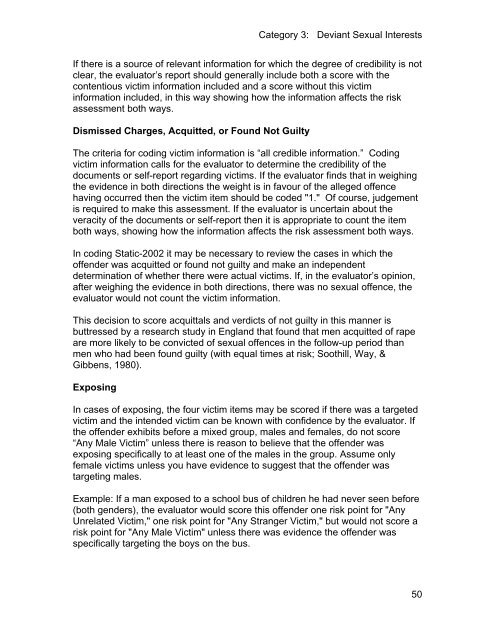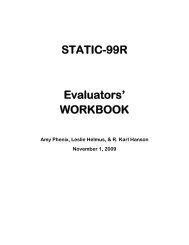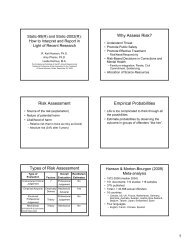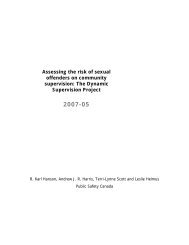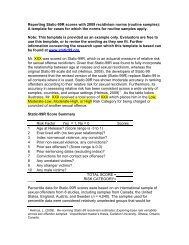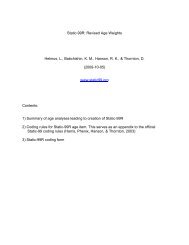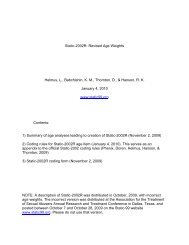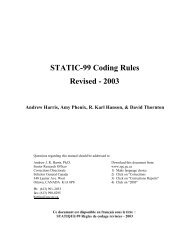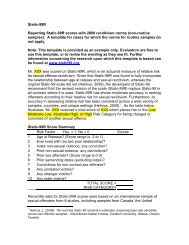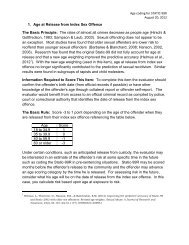Static-2002 coding rules (2009) - Static-99
Static-2002 coding rules (2009) - Static-99
Static-2002 coding rules (2009) - Static-99
You also want an ePaper? Increase the reach of your titles
YUMPU automatically turns print PDFs into web optimized ePapers that Google loves.
Category 3: Deviant Sexual Interests<br />
If there is a source of relevant information for which the degree of credibility is not<br />
clear, the evaluator’s report should generally include both a score with the<br />
contentious victim information included and a score without this victim<br />
information included, in this way showing how the information affects the risk<br />
assessment both ways.<br />
Dismissed Charges, Acquitted, or Found Not Guilty<br />
The criteria for <strong>coding</strong> victim information is “all credible information.” Coding<br />
victim information calls for the evaluator to determine the credibility of the<br />
documents or self-report regarding victims. If the evaluator finds that in weighing<br />
the evidence in both directions the weight is in favour of the alleged offence<br />
having occurred then the victim item should be coded "1." Of course, judgement<br />
is required to make this assessment. If the evaluator is uncertain about the<br />
veracity of the documents or self-report then it is appropriate to count the item<br />
both ways, showing how the information affects the risk assessment both ways.<br />
In <strong>coding</strong> <strong>Static</strong>-<strong>2002</strong> it may be necessary to review the cases in which the<br />
offender was acquitted or found not guilty and make an independent<br />
determination of whether there were actual victims. If, in the evaluator’s opinion,<br />
after weighing the evidence in both directions, there was no sexual offence, the<br />
evaluator would not count the victim information.<br />
This decision to score acquittals and verdicts of not guilty in this manner is<br />
buttressed by a research study in England that found that men acquitted of rape<br />
are more likely to be convicted of sexual offences in the follow-up period than<br />
men who had been found guilty (with equal times at risk; Soothill, Way, &<br />
Gibbens, 1980).<br />
Exposing<br />
In cases of exposing, the four victim items may be scored if there was a targeted<br />
victim and the intended victim can be known with confidence by the evaluator. If<br />
the offender exhibits before a mixed group, males and females, do not score<br />
“Any Male Victim” unless there is reason to believe that the offender was<br />
exposing specifically to at least one of the males in the group. Assume only<br />
female victims unless you have evidence to suggest that the offender was<br />
targeting males.<br />
Example: If a man exposed to a school bus of children he had never seen before<br />
(both genders), the evaluator would score this offender one risk point for "Any<br />
Unrelated Victim," one risk point for "Any Stranger Victim," but would not score a<br />
risk point for "Any Male Victim" unless there was evidence the offender was<br />
specifically targeting the boys on the bus.<br />
50


